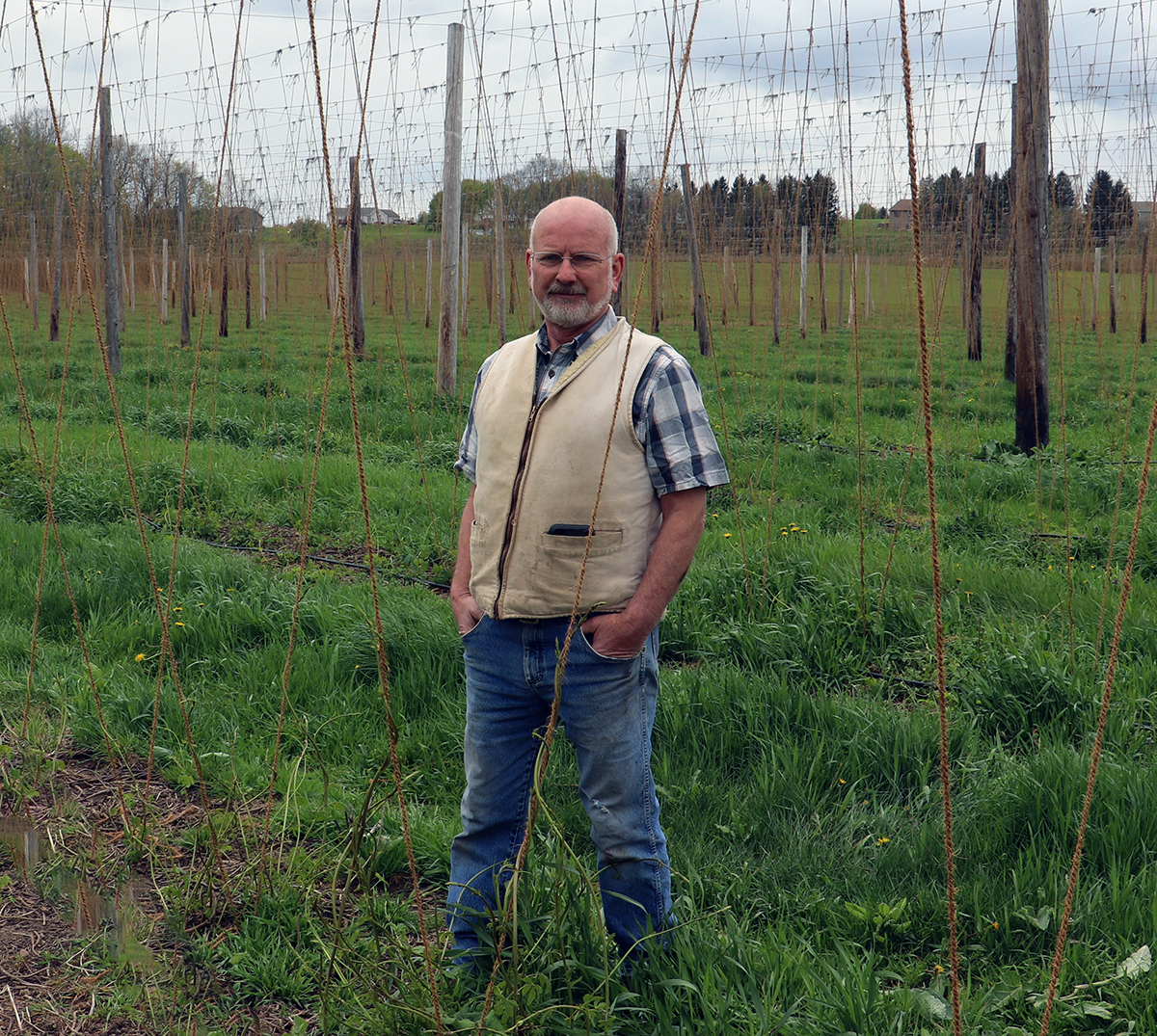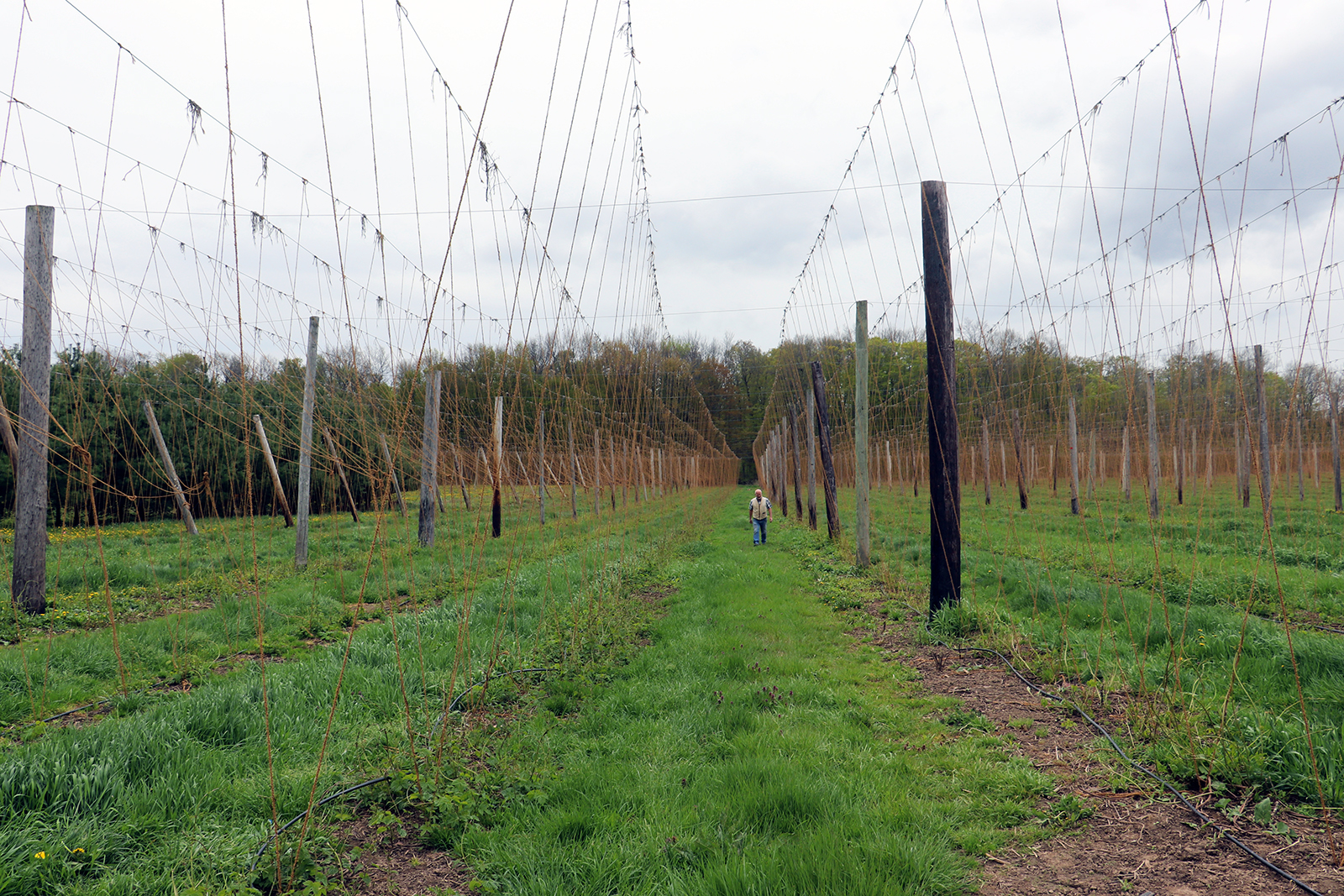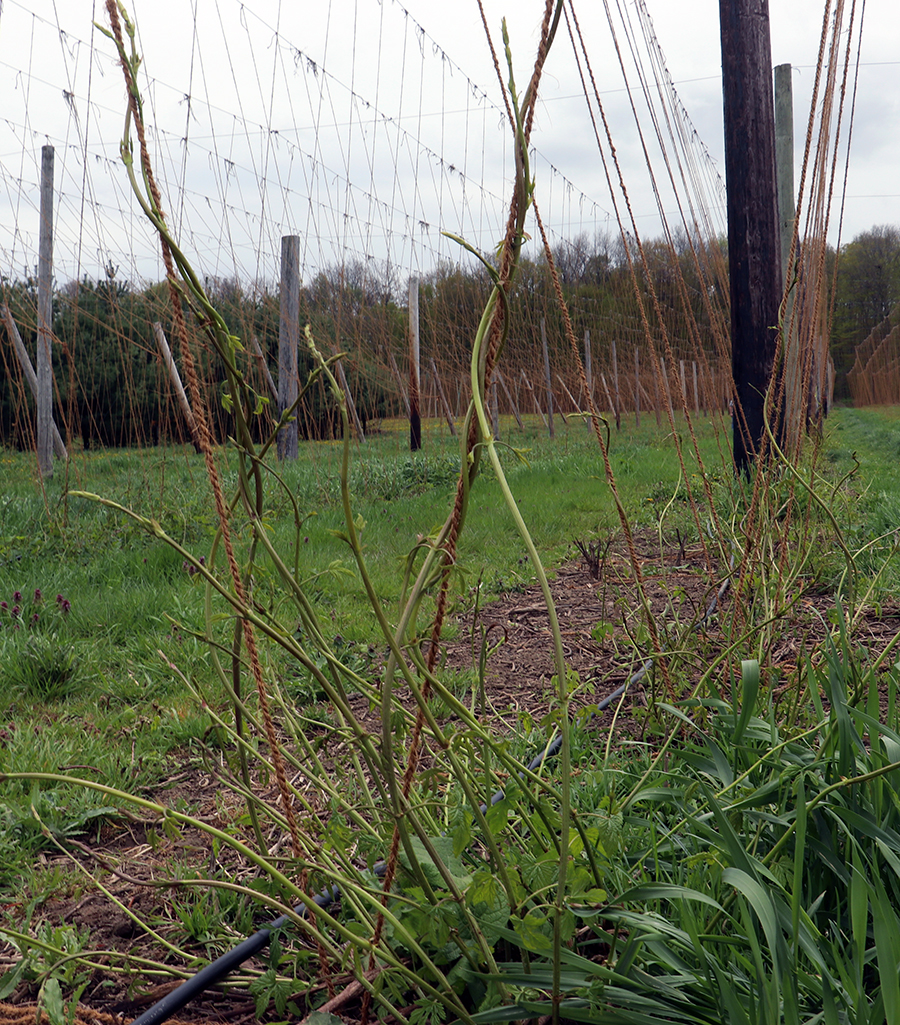Meet the Hops Hunters
This region features committed farmers, business alliances, and brewers looking to leverage the state’s beer history and the heirloom hops that helped build that history to quench a demand for unique, flavorful craft brews.


In a field broken up by a series of trellises stretched out in rows, family farmer Rick Pedersen, a fit, gray-bearded man wearing jeans, a flannel short-sleeved shirt, and beige vest, brings me over on a late-April afternoon to a foot-tall growth of greenery. Pedersen possesses a lot of agricultural accolades. Cornell University named Pedersen and his wife Laura, owners of Pedersen Farms in Seneca Castle, N.Y, Alliance for Science’s Farmer of the Year in 2020. The couple earned that recognition for their response to food shortages created by Covid-19, donating more than 90,000 pounds of produce to food banks. The interest in growing things started young for Pedersen. He created his first garden at 7, and now Pedersen Farms boasts 600 acres of organic vegetables and grain, including kale, which they sell to well-known restaurants such as sweetgreen.
But I came to his farm to talk about another notable achievement, one that doesn’t involve ingredients for a bowl or even a plate — but a glass, and a beer glass to be specific. Standing in the field, Pedersen introduces me to a variety of hops called New York. These rows of plants place Pedersen and his farm in the hops history books. For starters, he planted in 1999 the first commercial hops in the state since Prohibition. Those crops yielded some other history: One of his first customers, Ithaca Beer Company, produced in 2004 an all-New-York-State-hops beer. A bit of a Johnny Appleseed of hops, Pedersen routinely speaks around the state and the country about hop production. He sells his hops all over the United States, and you can find his hops in the product of several local breweries. He grows 16 varieties, including ones such as New York, which has some notable history itself.
In the 1800s, New York State served as the center of the hops industry. In fact, Madison County served as the first hops yard in the state. The local industry died after Prohibition, but in the last 10 years, since the boom of the craft beer industry, New York State brewers and growers have worked to put themselves back on the beer map. One way to do that is to distinguish themselves by growing and using heirloom hops, ones related to those that grew in the area during the industry’s peak and survived in the wild for more than 100 years. These varieties are unlike any others on the market, and growers like Pedersen seek to cultivate them along with the state’s craft-beer reputation.
“Both consumers and brewers are always looking for something new, something unique, something local,” Pedersen says.
As part of efforts to elevate the state’s hops, Pedersen belongs to the Northeast Hop Alliance, an organization of more than 790 members that seeks to promote awareness and defend interests of the area’s hop-growing industry. Executive Director Steve Miller led a two-year project that evaluates feral hops, ones that grew during the first hop boom in New York and that continue to grow in the area. The project evaluated about a dozen unique hops varieties. “There wasn't a lot of variety development,” Miller says of hops growing during the first beer boom. “People did find their own seedlings when the plants did propagate, and the largest planted variety at the time was the one called Cluster.”

New York hops variety grows on trellis in early spring. Photo by Allison Weis.
Thanks to Miller’s efforts, local farmers, including Pedersen, now grow these hops varieties. Pedersen received Bell Captain, a unique heirloom that was found on a farm in the Syracuse area. Another variety Miller found he named Prohibition, a reference to the location it was found, which suggested it was from a hops plant grown by a farmer during Prohibition so that he could make his own beer.
Pedersen’s New York variety, the one he shows me in his field, also possesses some interesting lineage. This heirloom variety’s ancestor was exported to England from New York in the early 1900s. But a Cornell professor on vacation and touring a plant repository at an English college saw it and brought it back to the States. After quarantining the plant for three years — and then Cornell growing the plant for two years — Pedersen became one of two growers to receive the plant to propagate.
Team members from Miller’s feral hops project tested all three of the varieties (Bell Captain, Prohibition, and New York) and found them to be new, unique varieties that differed from any variety available on the market. And Pedersen takes great pride in the fact that his hops come from strains grown to make beer in the late 1800s.
But beyond history, farmers and brewers find many reasons to grow heirloom varieties, including that these hops offer unique and sometimes old-fashioned flavors. Don Cazentre, New York State beer and wine writer, columnist, and author of the book New York Breweries, says, “There's a term called terroir, which is to say the climate, the soil, the minerals kind of make the same Chardonnay grape in New York different than a Chardonnay grape in California.” Terroir informs the flavor of hops the same way, adding unique region-dependent flavors to brews.
Heirloom hops connect contemporary growers and brewers to some fabled glory, one that they hope to reclaim.
Pedersen says heirloom hops deliver different flavors than those found in today's IPAs. “You know, there wasn't any such thing as an IPA or chocolate stouts and the infinite plethora of different beers we've got now. They basically were drinking ales and pilsners,” Pedersen says. “The hop isn't meant to stand out and be in your face like an IPA is today. It's supposed to be something that is drinkable, thirst quenching. Nowadays, the term is ‘sessionable,’ whereby you can drink two or three, and it’s O.K. Lower alcohol beers are meant for everyday life.”
Farming practices also have changed since that time. Unlike the contemporary reliance on female plants and their flowers, which result in no seed yield, growers in the 1880s also used male plants. They did this because the seeds added to the hops boosted the weights of their yield, according to Miller. This practice also ensured the spread of seeds across the state as “volunteers” (botany language for plants that grow on their own) flourished and contributed to a more genetically diverse hops crop. Now, hops growers only use female plants because seeds result in higher levels of fatty acids that negatively affect beer flavor stability.

Hops grower Rick Pederson walks along his field. Photo by Allison Weis.
In addition to flavor, these heirloom hops also possess some stamina. Afterall, because they could survive growing in New York for the past 100 years, they are known to be well suited to the climate and conditions and are likely resistant to diseases, Miller says. All of these factors play a role in transplanting hops that were developed in other areas and then brought to growers in New York State. In fact, many growers have been using varieties that were developed in the Pacific Northwest, and these are strains that have been developed in the last 50 years or less.
Plus the heirloom hops connect contemporary growers and brewers to some fabled glory, one that they hope to reclaim. The option of heirloom hops exists for New York growers because the state used to be the center of the hops world, says Miller. The history of hops growing is intertwined with the state’s history. In fact, hops were grown in New York before New York was even a state. Miller says hops were brought to the state as far back as the 1600s, and the first commercial hopyard farm was established in Madison County, the center of the state, in 1808. Miller notes the location was conducive to how growers would get their products to market. Eventually, with the advent of canals and railroads in Central New York, the industry expanded. The Central New York region also boasted good, well-drained soil, adequate rainfall, and an optimal latitude for growing hops commercially. Because of these conditions, the industry grew from about just a few acres in 1808 to about 40,000 acres by 1890.
Prohibition nixed that upward trajectory. And hops remained a small industry until around 1950 when most hops production moved to the Pacific Northwest, which had similar, if not better, growing conditions.
But as contemporary New York growers sought to distinguish themselves and realized they could cut the time frame of developing new varieties by a number of years and avoid the hefty cost of a plant breeding program by selecting hops growing wild, they began to hunt and grow heirloom varieties, Miller says. Growers and brewers also sought to rebuild the industry. In fact, New York’s hops industry has been trying to distinguish itself globally since the birth of the craft industry, Pedersen says. Since 2010, the number of craft breweries grew in the U.S from under 2,000 in 2010 to almost 9,000 in 2020. Consumers would “like to buy local, but local needs to be able to support flavor profiles that a brewer wants, because that's what the customer wants,” Pedersen says.
And since Miller’s feral hops project ended, other hops champions have taken up the cause to bring new strains to New York’s hops industry. People such as Kara Johnston, the vice president of sales and marketing and self-proclaimed “Hops Goddess” of Chimney Bluffs Hoppery, the largest hops farm in New York state located in Wolcott, NY. They yield 37,000 pounds of New York State grown and certified, a designation that signals to consumers not only compliance with farming standards but also that the beer in their hand helps the local hops industry. Johnston collaborates with brewers to bring hops to the state that would grow well in the New York climate with the goal of giving them a competitive edge. “Now we're growing hops that they're not growing out west. We're not going to be the Yakima,” she says, referencing the brewery powerhouse that remains in the Pacific Northwest. “But we will be the Yakima of the East.”

Our pursuit of outdoor joy is remiss without the acknowledgement of the occupation of unceded Indigenous land. We are students and journalists working, writing, and living on the land of the Haudenosaunee Confederacy, comprising the Six Nations made up of the Mohawk, Onondaga, Oneida, Cayuga, Seneca, and Tuscarora nations. However, acknowledgement is not enough. Read More.